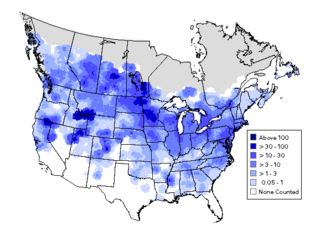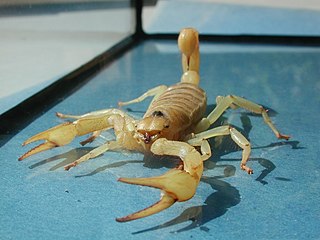
The yellow-billed magpie(Pica nuttalli), also known as the California magpie, is a large corvid that inhabits California's Central Valley and the adjacent chaparral foothills and mountains. Apart from its having a yellow bill and a yellow streak around the eye, it is virtually identical to the black-billed magpie (Pica hudsonia) found in much of the rest of North America. The scientific name commemorates the English naturalist Thomas Nuttall.

The horned lark or shore lark is a species of lark in the family Alaudidae found across the northern hemisphere. It is known as "horned lark" in North America and "shore lark" in Europe.

The International Ornithologists' Union (IOU) is an international organization for the promotion of ornithology. It links basic and applied research and nurtures education and outreach activities. Specifically, the IOU organizes and funds global congresses on ornithology at regular intervals, sets up and supports commissions and committees on various aspects of avian biology and conservation, and initiates and backs other international ornithological activities with specific aims consistent with its own mission and goal. It discloses the names and professional affiliations of its members on its website to encourage international collaboration and networking. The IOU acts as the Ornithology Section of the IUBS.
Maps is the plural of map, a visual representation of an area.

Mist nets are nets used to capture wild birds and bats. They are used by hunters and poachers to catch and kill animals, but also by ornithologists and chiropterologists for banding and other research projects. Mist nets are typically made of nylon or polyester mesh suspended between two poles, resembling a volleyball net. When properly deployed in the correct habitat, the nets are virtually invisible. Mist nets have shelves created by horizontally strung lines that create a loose, baggy pocket. When a bird or bat hits the net, it falls into this pocket, where it becomes tangled.
The Cornell Lab of Ornithology is a member-supported unit of Cornell University in Ithaca, New York, which studies birds and other wildlife. It is housed in the Imogene Powers Johnson Center for Birds and Biodiversity in Sapsucker Woods Sanctuary. Approximately 250 scientists, professors, staff, and students work in a variety of programs devoted to the Lab's mission: interpreting and conserving the Earth's biological diversity through research, education, and citizen science focused on birds. Work at the Lab is supported primarily by its 75,000 members.

Wells National Estuarine Research Reserve, also known as Wells Reserve, is a National Estuarine Research Reserve located in Wells, Maine.

The ʻapapane is a small, crimson species of Hawaiian honeycreeper endemic to the Hawaiian Islands. They are the most abundant and widely distributed honeycreeper and are found on the islands of Hawaiʻi, Maui, Lānaʻi, Kauaʻi, Molokaʻi and Oʻahu.
The Southeastern Arizona Bird Observatory (SABO) is a nonprofit membership-supported scientific and educational organization founded in 1996 in Bisbee, Arizona, USA. The mission of the Southeastern Arizona Bird Observatory is to promote the conservation of the birds of southeastern Arizona, their habitats, and the diversity of species that share those habitats through research, monitoring, and public education. The observatory's founders are Tom Wood and Sheri Williamson, former managers of The Nature Conservancy's Ramsey Canyon Preserve.

Sage-grouse are grouse belonging to the bird genus Centrocercus. The genus includes two species: the Gunnison grouse and the greater sage-grouse. These birds are distributed throughout large portions of the north-central and Western United States, as well as the Canadian provinces of Alberta and Saskatchewan. The International Union for Conservation of Nature classified the C. minimus species as endangered in 2020 and C. urophasianus as near threatened in 2016.
Tag and release is a form of catch and release fishing in which the angler attaches a tag to the fish, records data such as date, time, place, and type of fish on a standardized postcard, and submits this card to a fisheries agency or conservation organization. Anglers who catch tagged fish report their location, date, and time, as well as the tag number to established points of contact. South Carolina has had such a program since 1974.

A bird atlas is an ornithological work that attempts to provide information on the distribution, abundance, long-term change as well as seasonal patterns of bird occurrence and make extensive use of maps. They often involve a large numbers of volunteers to cover a wide geographic area and the methods used are standardized so that the studies can be continued in the future and the results remain comparable. In some cases the species covered may be restricted to those that breed or are resident. Migration atlases on the other hand cover migratory birds depict maps showing summaries of ringing and recoveries.
Partners in Flight / Compañeros en Vuelo / Partenaires d’Envol is an organization launched in 1990 in response to growing concerns about declines in the populations of many land bird species, and to emphasize the conservation of birds not covered by existing conservation initiatives. The initial focus was on Neotropical migrants, species that breed in the Nearctic and winter in the Neotropics, but the focus has spread to include most land birds and other species requiring terrestrial habitats. The central premise of Partners in Flight (PIF) has been that the resources of public and private organizations in North and South America must be combined, coordinated, and increased to achieve success in conserving bird populations in the hemisphere. PIF supports education initiatives and is a title sponsor of International Migratory Bird Day.

Geographic Information Systems (GIS) has become an integral part of aquatic science and limnology. Water by its very nature is dynamic. Features associated with water are thus ever-changing. To be able to keep up with these changes, technological advancements have given scientists methods to enhance all aspects of scientific investigation, from satellite tracking of wildlife to computer mapping of habitats. Agencies like the US Geological Survey, US Fish and Wildlife Service as well as other federal and state agencies are utilizing GIS to aid in their conservation efforts.
The Great Basin Bird Observatory is an ornithological nonprofit organization based in Reno, Nevada. Founded in 1997, its mission is to conserve birds and their habitats in Nevada and adjoining regions through partnerships, applied research, and education.

The fauna of the U.S. State of Nevada is mostly species adapted to desert, temperature extremes and to lack of moisture. With an average annual rainfall of only about 7 inches (180 mm), Nevada is the driest – and has the largest percentage of its total area classified as desert – of all states in the United States. Two-thirds of the state is located within the largest desert on the North American continent, the Great Basin Desert, while the lower one-third is the Mojave Desert.
The Common Bird Monitoring Program is a citizen science bird monitoring program of India. It is a pioneer project that aims to engage general public in the collection of baseline data on 18 common bird species. Data collected will be used to map species abundance and distribution throughout the Indian subcontinent.
The American Federation of Aviculture, Inc. (AFA) is a national organization dedicated to aviculture, whose purpose is to educate the public and assist members regarding best practices for keeping and living with exotic birds. Local affiliate bird clubs throughout the United States, including Puerto Rico, along with national and international specialty organizations; comprise the Federation. The American Federation of Aviculture is registered as a non-profit 501(c)3 educational organization, with a business office located in Austin, Texas.

Bluebonnet Swamp Nature Center is a 103-acre nature conservation park administered by the Recreation and Park Commission for the Parish of East Baton Rouge, and located at 10503 N. Oak Hills Parkway, Baton Rouge, Louisiana 70810. It is open to the public Tuesday - Saturday from 9 a.m. to 5 p.m., and Sunday from noon to 5 p.m. for a nominal fee. The facility was opened as BREC's first nature conservation based park on 17 May 1997.











